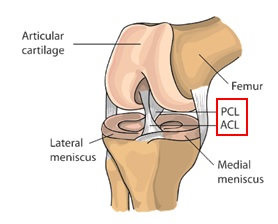Where is the Anterior Cruciate Ligament (ACL)?

The cruciate ligaments form an 'X' configuration with the knee joint and keeps the joint in place. The anterior cruciate ligament (ACL) is located in front of the posterior cruciate ligament (PCL) and helps to control rotation of the knee as well.
Anterior Cruciate Ligament (ACL) Injury
The ACL is commonly injured as a result of twisting of the knee while the foot remains planted during contact sports such as soccer, rugby or following a fall. You may hear a "pop" sound, develop immediate swelling of the knee within hours and will not be able to continue with the activity. The associated injuries include injury to the surrounding ligaments, meniscus tears and cartilage damage.
Signs of ACL injury
Short Term
-
Recurrent swelling
-
Pain
-
Locking of knee
-
Instability upon returning to sports
Long Term
-
Decreased function of the knee
-
Damage to underlying menisci and cartilage
-
Early onset of osteoarthritis
Treatment Options
Non-Operative Management
Individuals who are relatively inactive, engage in non-intensive sports and with no significant chronic knee instability may be treated non-operatively with:
-
Physiotherapy
-
Use of protective knee brace
However, there is an increased risk of recurrent injury and possible early development of osteoarthritis.
Physiotherapy
Physiotherapy is recommended to assist the individual to regain full range of movement and strength of the knee joint. This is important to ensure the knee joint is in the best condition possible before surgery to allow better recovery.
Surgical Reconstruction
Complete ACL tear does not heal. For an active individual with recurrent instability, surgical reconstruction of the ACL is recommended.
ACL reconstruction is performed using key-hole surgery. It is one of the most commonly performed surgery of the knee. The aim of the surgery is to restore stability and improve the function of the knee.
During surgery, associated damage to the surrounding ligaments and tissues can be addressed at the same time.
Key Features of ACL Surgery
Anaesthesia
The individual will require general anaesthesia during the procedure. The risks of anaesthesia will be elaborated by the Anaesthetist during pre-operation screening and counselling.
Graft Choice
For primary ACL reconstruction, the graft of choice is often the individual's own tendons (autograft). The inner hamstring tendons are used for majority of the cases. Alternatively, the less commonly used graft is the patellar tendon.
Other graft sources such as donor tendons (allograft) can also be used, especially for cases requiring repeated surgery.
Implants
Bone tunnels are created in the thigh (femur) bone and tibia (shin) bone. The graft is introduced into the tunnels and secured using implants.
These implants are necessary to fix the graft to the bone tunnels before the graft integrates to the bone to act as the ACL. The implants may be metallic or non metallic.
Post Surgery Follow Up
Consultation
Regular follow up is necessary after the surgery for your doctor to monitor your progress and guide your rehabilitation.
Rehabilitation
In general, most patients will need to use crutches and wear a knee brace for around six weeks after surgery to reduce over-stressing the graft.
Each individual will undergo a structured rehabilitation programme after the surgery, with the focus on regaining the range of movement and strength of the operated knee. Functional exercises are also included to facilitate the patient's return to activities and sports.
The whole rehabilitation process typically takes about nine to twelve months.
Download PDF, 1.57MB, PDF
